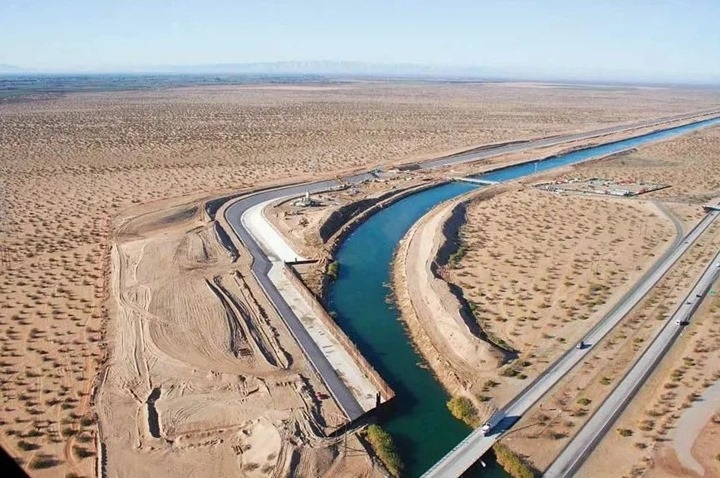70 years ago, in July 1954, construction began on one of the greatest human-realized objects of the 20th century, the – Karakum River, following the decision to grow more Turkmen cotton. The planned project turned into a century-old dream of the Turkmen people to bring water to the virgin lands of the flat part of the Kopet Dag foothills, where oases would bloom in the vicinity of the Karakum. At the same time, it was planned to build the first two reservoirs of the future hydraulic system – Tedzhensky and Sary-Yazynsky.

The construction was international both in relation to the participants and the material and technical base: 200 cities of the USSR sent machines, graders, transformers, excavators, cranes, and scaffolding to help. Industrial enterprises of Moscow, Leningrad (St. Petersburg), Sverdlovsk (Ekaterinburg), Yaroslavl, Gorky (Nizhny Novgorod), Minsk, Tashkent, Dushanbe supplied their products.
As it was
At the initial stage, the «channel was pulled by » on both sides: from the side of the city of Mary it went dry, and from the beginning of the artificial river to the Kerka – with water. The work went like this: first, bulldozers, scrapers, and excavators dug a small, fifteen-kilometer-long trench and filled it with water, then they developed a channel for a full profile using powerful dredgers.
On this long initial site, along with the formation of many complex hydraulic units and connections, structures, the Mary Construction and Installation Department was created on site, and in the city of Mary the construction trust «Turkmenhydrostroy» – began to function, the predecessor of the current Production Association «Garagumderýagurluşyk», the head office and production base of which is still located in the Murghab oasis.
Along the way, the river crossed watercourses, pipes and overpasses, and in order for them to diverge from the «river, each in their own direction, special engineering units were arranged, called aqueducts, dukers, when pipelines could pass along the bottom, and small rivers were placed in pipes, etc.
In certain places, the Karakum River merged with the Murghab and Tejen rivers [The Karakum Canal did not merge with the Tejen River; it passes over and under the Tejen River in several aqueducts, as well as over the Murghab — approx. Rivers.Help!], bypassed obstacles, overgrew bridges, and soon, thanks to the bold design decisions of engineers and the dedicated work of builders, it already had a length of 400 km.
Describing the opening of one of the polling stations, the newspaper «Turkmen Spark» wrote:
«…Through a gap made by buckets, first timidly, and then faster and faster, Amu Darya water rushed along the riverbed towards Tejen. Big water filled the new channel in 15 days; on November 27, 1960, it merged with the Tejen» River.
Resist filtration
The man-made river had to travel three hundred kilometers through quicksand, so a calculation of moisture losses was made, the groundwater regime under the influence of filtration was predicted, which made it possible to implement the project, which was carried out without concrete lining of the bottom and sides of the riverbed.
Today’s hydraulic engineers claim that the old bottom of the main channel of the artificial river has silted up enough over the decades, has become denser, and does not require additional strengthening, which cannot be said for the recently built smaller size of outlet and inlet auxiliary canals, water intake and distribution units, irrigation collectors, inter-farm canals in etraps and velayats. Here, engineers recommend using environmental methods and methods developed and tested in the soil and climatic conditions of the country that can minimize water losses when transporting precious moisture. You can concrete the sides, use moisture-proof materials when laying new channels, remove branches into the pipe, strengthen the banks with cladding, brickwork, and chemical methods. The implementation of water-saving measures at hydraulic structures was repeatedly discussed at government meetings, during which issues of water resources were touched upon.
Forest plantings for water conservation
There are environmental methods for strengthening the coastal zone and regulating the groundwater level near the passage of water. This is the creation of forest strips accompanying the riverbed on both sides, taking into account the necessary space for free access to the river by earth-moving equipment. Every year, watermen plant several thousand trees of conifers and hardwoods, including fruit trees, most of all mulberries. This contribution to the implementation of the National Forestry Program of Turkmenistan, such as garbage collection and cleaning for sanitary purposes of the inter-farm irrigation network, as well as the territory near the man-made river – planned work, which falls under the jurisdiction of one of the structures of the State Committee for Water Resources of Turkmenistan – Association «Garagumsuwhojalyk». It can be called a brain center for planning the necessary design, construction, installation and repair work at hydraulic facilities of the Karakum River system. This work is carried out all year round, now – is in summer mode, taking into account weather conditions.
The biological method of saving the riverbed from overgrowing with reeds on a long-term basis remains stocking the river and reservoirs, as well as canals and collectors. A special structure of the State Committee for Water Resources of Turkmenistan is engaged in raising fry of large herbivorous fish – carp, silver carp, white and black carp, annually releasing juveniles into the waters of the general irrigation system of the Karakum River.
Modern technology for watermen
Karakum – is a plain inclined towards the Caspian Sea, and water flows along the river by gravity, which was also taken into account when implementing the project. For cleaning work, powerful dredgers are used, as well as earth-moving units of the companies «Komatsu» and «Caterpillar», which make up a significant fleet of equipment from the production association «Garagumderýagurluşyk» in terms of the number and variety of machines. Since 2017, 85 units of dredgers of various brands, capacities and manufacturers have been purchased; during this year alone, 8 such units have been put into operation for existing bowl cleaners and reservoir tanks, and channel branches. Such a device collects silt and sediment layers from the bottom and throws them ashore under powerful pressure with water. In this case, the water is filtered back into the canal, and the silt and sand remain and become part of the coastal small hills of the – bairs. This deepens the bottom, brightens the water, and allows it to pass unhindered. Starting in 2023, domestic hydraulic builders received 32 units of modern excavators, as well as 7 bulldozers.
Monitoring and control
As part of the introduction of elements of the digital economy into industry development plans, water workers are introducing modern water metering technologies into the monitoring of the water content of the Karakum River and increasing the experience of injecting the industry into the digital plane.
To date, along the entire length of the channel (from the head part, the middle course of the man-made river to the regulated end point in the Bereket etrap of the Balkan velayat), specialists in the water sector of Turkmenistan have installed 70 copies of the device, produced in the Kyrgyz Republic from materials resistant to corrosion and destruction from the influence of weather conditions. Currently, commissioning work is being carried out, and after the launch of the built structure, the information received in «live broadcast mode» will flow to the central control center of the State Committee for Water Resources, as well as the monitoring center.
As explained in the State Committee, the device is called an ultrasonic water level measurement sensor, provides information about the water supply of the river, is used to control its flow rates, and will indicate water losses during the passage of areas, which will improve control over water consumption. This compact device is located above the water on a stationary support – bracket, bridge or in the so-called measuring well. The entire system can operate on the established form of communication, provide data in real time, and serve to create a timely picture of the distribution of hydraulic resources during floods or water shortages. The accumulated data in electronic form will make it possible to quickly conduct a comparative analysis of the flow rate of the country’s main freshwater artery.
Elena Dolgova (Türkmenmetbugat)




